When the Editor requested a piece on how to catch flathead for the table I thought, ‘everyone knows how to catch a flattie’. But on short reflection I had to remind myself of my weekly experiences as a fishing guide that the world’s not actually like that.
Foreign as it may seem to most salt-of-the-earth Aussies, not everyone has a grandfather, father, uncle or mother with a boat, or the skills to be able to walk the shallow margins of most NSW estuaries tossing lures for one of the tastiest fish of the sea, the flathead.
Hands-down, I’ll chew on a tasty piece of flathead any day. In fact, why people fish for bream and snapper as table fish makes for interesting discussion but that’s another story.
We can break our flatties story down into two distinct areas: Inshore and estuaries, and offshore or in large, deep bays like Jervis Bay on the South Coast.
We’ll concentrate our target zone here from 20m-60m of water and the main species here will be eastern blue-spotted flathead, southern sand flathead and tiger flathead.
Without going into the whole species description, variations of these three species tend to make up the bulk of the catch from Moreton Bay in the north to the northern Tasmania. The book Sea Fishes of Southern Australia is a great reference tool to have on the boat or in your kit for more accurate identification.
The key to any offshore flattie bash, as is the case for any boating or fishing trip, is preparation.
Source a good chart and scour the depth contours to locate the sandy bottom that flathead prefer. The offshore deepwater entrances to bays and rivers are good starts; these systems provide regular exchange of nutrients, small baitfish and crustaceans on each tide and these are prime flathead food.
Flatties are ambush predators that most of the time lie on the bottom waiting to ambush any food that happens to swim past within striking distance. Their long, powerful tails provide intense bursts of energy that make them exceptionally quick over distances of less than 5m.
The most common rig used by the offshore bottom-bashing brigade would have to be the old-fashioned paternoster rig. If you don’t know what that is then I do suspect you know how to drive Google or YouTube.
It’s basically a two-hook rig with a big snapper lead or sinker on the end to keep the bait as close to the bottom as possible.
This is also the domain of the handline with 20lb mono line. It’s old-school, cheap and easy and does the job as long as you don’t keep putting your foot in the 20m-50m of line all over the deck.
These days I prefer a short 3kg-6kg graphite rod with 10lb braided line and a long 20lb leader. Mono will work on a rod but the hook-up rate is far superior with the zero stretch of braided line.
Any good tackle store will help you out with a basic kit and if they don’t, go and shop elsewhere.
The simple skill of the bottom bash is to drop the whole rig to the bottom and keep in contact with the bottom as the boat is drifting. Strike when you get a bite and then pull up when you feel the weight.
With the two-hook paternoster I find the bottom hook should have a durable bait such as squid or carp, yes carp. (I’ll talk about that in another article).
The top hook should be rigged with a soft plastic like an old school orange Mister Twister. The Squidgy Lobby is the next best thing, or anything that has a wriggly tail will do. Hooks around 3/0-4/0 are the go. You’ll be surprised how many fish are actually caught on the lure as opposed to the bait.
Flathead tend to congregate in patches so once you have identified an area where fish are biting, multiple drifts over that area should produce. A GPS and sounder help you achieve far better results, otherwise take two landmarks when you get a fish and try to come back to where those two landmarks intersect for the next drift.
So that’s offshore. Out at 7am and home by 11am, ready for a tasty lunch of fresh fish and an afternoon siesta once the sea breeze has kicked in1
The estuaries are another world and while it’s fair to say that bait catches fish, I’d back myself any day to catch more estuary dusky flathead on lures than bait, and that includes live bait.
The lifelike action of a soft plastic or hard-bodied lure is difficult to beat as long as you have a nice graphite rod and braided line with a leader.
And for god’s sake, leave the swivels at home if you’re using lures; the presentation of the lure needs to be lifelike and swivels drop catch rates.
Some of the major considerations in targeting dusky flathead in the estuaries are tides and structure.
The less water you have in a river or creek, the more chance you have of catching a fish because all the bait is now in a concentrated area after the shallow flats have drained out with the receding tide.
There are plenty of variations on this but low tide is when I start if I’m fishing a new tidal location.
Weeds and rock bar edges are the next bit of structure to look for.
Flatties will also be found in very shallow water on the higher tides as they lie in wait to ambush unsuspecting prawns. In fact over the last few years we have seen a real shift in the way a lot of good anglers chase a feed of flathead, with diving hardbodies becoming the lures of choice.
Any lure cast along the edge of structure will eventually produce a result.
Walking shallow sand flats at high tide with a small kit of diving lures and soft plastics can be dynamite.
The age-old method of poddy mullet on a paternoster rig is also deadly, and also great fun for the kids when it comes to simply cutting a hole in the top of a juice container and filling it with bread to catch some poddy mullet. Weight the container down with a rock and remember the bag limit of 20 under 15cm.
You can cast a poddy off a weedy edge on the run-out tide or drift a paternoster rig with a single hook behind the boat. Slow trolling may also produce good results.
Trolling hardbodies slowly down a weed edge is the method preferred by many Queenslanders and the majority of entrants in each year’s Gold Coast Flattie Classic use this method with great success. Just keep checking the lure for weed as you go.
Facts
FOR THE TABLE
For a quick online demo on how to fillet a flathead try this YouTube video by the guys at Weflick Fishing: www.youtube.com/watch?v=wXKLqZPX1e4
When it comes down to the eating, it’s pretty hard to beat shaking some filleted tails in a plastic bag with plain flour, salt and pepper and giving them a quick shallow-fry in olive oil and eating them fresh that day.
I don’t mind a dash of curry powder in with the mix and my three-year-old daughter invented the best sauce known to man, which is mayonnaise, mild American mustard and lemon juice. Grab a dash of fresh rocket from the garden to garnish and the kids will be like the seagull in the movie Finding Nemo, ‘mine, mine, mine!’
Washed down with an ice-cold beverage of your choice, you can sit back, laugh and think, ‘this is Aus-tray-li-yaaah’.
Facts
BIG GALS
It wouldn’t be a flattie article without a reminder that big dusky flathead, over about 65cm, are all females and a very important part of keeping us in stock of yummy flattie tails.
When you do catch a big gal, carefully net it and handle it with a heavy glove, ensuring you support the weight of the body for a great picture before you release her. Don’t keep her out of the water more than a minute and if you want more pictures, lower the net into the water for a minute or so to allow the fish to breathe.
Don’t ever hang a flattie up by the lower jaw for a picture if you intend to release the fish. This may disengage her neck vertebrae and she won’t survive.
I’d like to see us have a slot limit of 40cm-55cm and a bag limit of five fish to sustain the fishery well into the future. Please consider releasing all fish over 55cm. – GR
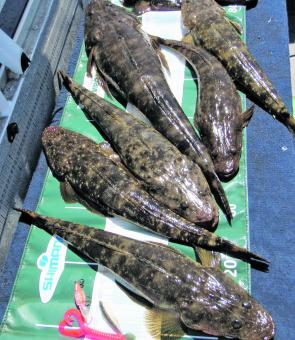
A great feed of succulent dusky flathead ready for the icebox of the fillet table.

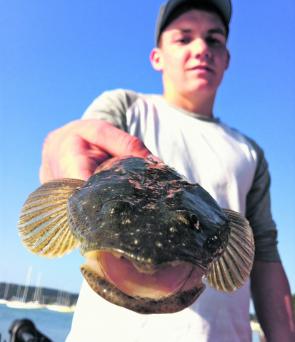
With a mouth like that, any passing fish, crustacean or other critter has to be pretty large or very fast to avoid becoming flathead food.
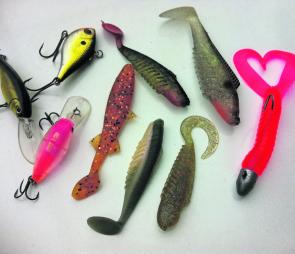
A selection of hard and soft flathead lures for the estuary. Plastics should be 3”-6” long and the hardbodies should be able to kick up the bottom sand as they swim along.
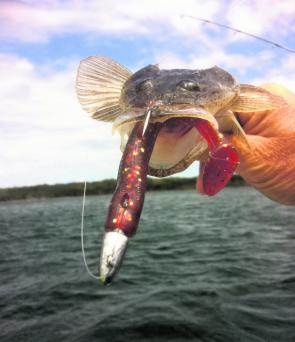
Even a small flathead has a big mouth and is greedy. The minimum size for a dusky is 36cm and for the offshore species 33cm. The dusky has a prominent dark spot on its tail.
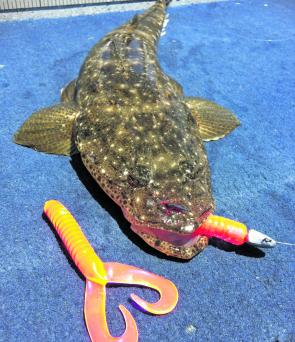
The orange twin-tail grub such as the venerable Mister Twister is a favourite soft plastic in the estuary and offshore.

The age-old paternoster rig has always been great for bottom-bashing for flatties offshore. It gets a 21st Century update with a soft plastic on the top hook. These are 3/0-4/0 octopus/suicide hooks.
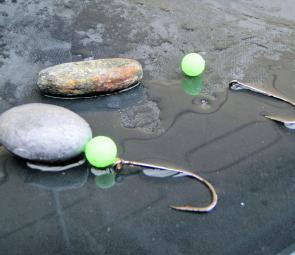
The normal bottom rig for drifting a live or cut bait in the estuary or nearshore.

Lipless vibrating lures are good for flatties because they sink and can be worked deep or shallow.





